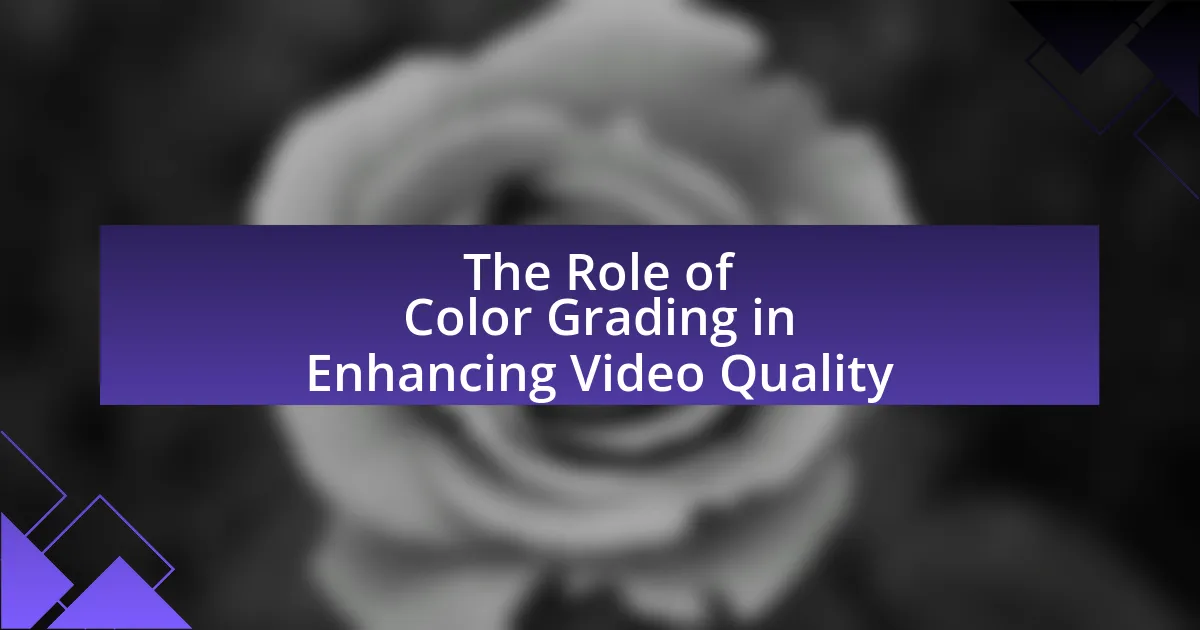Color grading is a vital process in video production that enhances video quality by adjusting color balance, contrast, and brightness to create a specific aesthetic and emotional impact. This article explores the significance of color grading in visual storytelling, detailing its effects on viewer perception and emotional engagement. It covers primary techniques used in color grading, the differences in approaches across various genres, and the essential tools and software available for colorists. Additionally, it addresses common misconceptions, best practices, and the psychological effects of color on audiences, providing a comprehensive understanding of how effective color grading contributes to a cohesive and impactful visual narrative.

What is the Role of Color Grading in Enhancing Video Quality?
Color grading plays a crucial role in enhancing video quality by adjusting the color balance, contrast, and brightness to create a desired aesthetic and emotional impact. This process allows filmmakers to establish a specific mood or tone, making the visuals more engaging and cohesive. For instance, studies have shown that color grading can significantly influence audience perception; a well-graded film can evoke emotions more effectively than one with flat colors. Additionally, color grading helps to ensure consistency across different shots, which is essential for maintaining visual continuity in storytelling.
How does color grading impact the overall aesthetic of a video?
Color grading significantly impacts the overall aesthetic of a video by altering its color palette, contrast, and brightness, which influences the viewer’s emotional response. This process enhances visual storytelling by creating mood and atmosphere; for instance, warmer tones can evoke feelings of comfort or nostalgia, while cooler tones may convey tension or sadness. Studies show that color grading can increase viewer engagement and retention, as it helps to establish a cohesive visual style that aligns with the narrative. For example, films like “Mad Max: Fury Road” utilize distinct color grading to enhance the post-apocalyptic aesthetic, making the visuals more striking and memorable.
What are the primary techniques used in color grading?
The primary techniques used in color grading include color correction, color enhancement, and color matching. Color correction adjusts the overall color balance and exposure to achieve a natural look, often using tools like lift, gamma, and gain to manipulate shadows, midtones, and highlights. Color enhancement focuses on intensifying specific colors or creating a desired mood, often employing LUTs (Look-Up Tables) to apply predefined color styles. Color matching ensures consistency across different shots or scenes, utilizing reference images and scopes to align colors accurately. These techniques are essential for achieving a polished and visually appealing final product in video production.
How do color grading techniques differ between genres?
Color grading techniques differ significantly between genres to evoke specific emotions and enhance storytelling. For instance, horror films often utilize desaturated colors and high contrast to create a sense of unease, while romantic comedies typically feature warm, vibrant hues to convey joy and intimacy. Action films frequently employ a cooler color palette with high saturation to amplify intensity and excitement. These genre-specific choices are supported by studies indicating that color can influence viewer perception and emotional response, such as research published in the Journal of Media Psychology, which highlights how color affects mood and engagement in film.
Why is color grading essential in the post-production process?
Color grading is essential in the post-production process because it enhances the visual storytelling by adjusting the color balance, contrast, and saturation of footage. This process allows filmmakers to create a specific mood or atmosphere that aligns with the narrative, making the content more engaging for viewers. For instance, studies show that color can influence emotions; warmer tones may evoke feelings of comfort, while cooler tones can create a sense of tension. Additionally, color grading ensures visual consistency across scenes, which is crucial for maintaining the audience’s immersion in the story.
What are the common misconceptions about color grading?
Common misconceptions about color grading include the belief that it is solely about making footage look more vibrant or artistic, when in fact, it serves to ensure color consistency and enhance storytelling. Many people think color grading can fix poorly shot footage, but it cannot replace good cinematography or proper lighting. Additionally, some believe that color grading is only necessary for high-budget productions, while in reality, it can significantly improve the quality of any video, regardless of budget. Lastly, there is a misconception that color grading is a quick process, but it often requires careful attention to detail and can be time-consuming to achieve the desired results.
How does color grading contribute to storytelling in video?
Color grading significantly enhances storytelling in video by establishing mood, emphasizing themes, and guiding audience emotions. Through the manipulation of colors, filmmakers can create a specific atmosphere that aligns with the narrative; for instance, warm tones may evoke feelings of nostalgia or comfort, while cooler tones can convey tension or sadness. Research indicates that color can influence viewer perception and emotional response, as seen in studies like “The Impact of Color on Marketing” by Satyendra Singh, which highlights how color affects consumer behavior and emotional engagement. Thus, effective color grading not only beautifies the visual experience but also deepens the audience’s connection to the story being told.

What are the key components of color grading?
The key components of color grading include color correction, color enhancement, and the use of color wheels and curves. Color correction involves adjusting the footage to achieve a neutral color balance, ensuring that whites appear white and colors are accurately represented. Color enhancement focuses on creatively altering colors to evoke specific moods or styles, often using saturation and contrast adjustments. Color wheels and curves are tools that allow precise control over the tonal range and color balance, enabling colorists to manipulate shadows, midtones, and highlights effectively. These components work together to improve the visual storytelling and emotional impact of video content.
What tools and software are commonly used for color grading?
Commonly used tools and software for color grading include DaVinci Resolve, Adobe Premiere Pro, Final Cut Pro, and Avid Media Composer. DaVinci Resolve is renowned for its advanced color correction capabilities and is widely used in the film industry, while Adobe Premiere Pro offers integrated color grading tools that are user-friendly for video editors. Final Cut Pro provides a seamless workflow for Mac users, and Avid Media Composer is favored for its robust editing features in professional environments. These tools are essential for enhancing video quality through precise color adjustments and grading techniques.
How do different software options compare in terms of features?
Different software options for color grading, such as DaVinci Resolve, Adobe Premiere Pro, and Final Cut Pro, compare significantly in terms of features. DaVinci Resolve is renowned for its advanced color correction tools, including HDR grading and a node-based workflow, which allows for intricate adjustments and effects. Adobe Premiere Pro offers robust integration with other Adobe products and features like Lumetri Color for basic color grading, but it lacks the depth of Resolve’s color tools. Final Cut Pro provides a user-friendly interface with powerful color grading capabilities, including color wheels and curves, but it may not match the extensive features of Resolve. These distinctions highlight how each software caters to different user needs and expertise levels in video color grading.
What role do LUTs (Look-Up Tables) play in color grading?
LUTs (Look-Up Tables) serve as essential tools in color grading by providing a predefined mapping of input colors to output colors, enabling consistent and efficient color transformations. They allow colorists to apply complex color adjustments quickly, ensuring that the visual style aligns with the creative vision of a project. LUTs can be used to emulate film stocks, create specific moods, or achieve a desired aesthetic, thereby enhancing the overall video quality. Their effectiveness is supported by the fact that they streamline the color grading process, allowing for real-time previews and adjustments, which is crucial in professional video production environments.
How does color grading affect viewer perception?
Color grading significantly influences viewer perception by altering the emotional tone and visual aesthetics of a video. This process enhances storytelling by using specific color palettes to evoke feelings; for instance, warmer tones can create a sense of comfort, while cooler tones may evoke sadness or tension. Research indicates that color grading can affect audience engagement and emotional responses, as demonstrated in a study by the University of California, which found that viewers rated films with effective color grading as more emotionally impactful. Thus, the strategic use of color grading not only enhances visual quality but also shapes how viewers interpret and connect with the narrative.
What psychological effects do colors have on audiences?
Colors significantly influence the psychological responses of audiences, affecting emotions, perceptions, and behaviors. For instance, red often evokes feelings of excitement or urgency, while blue tends to promote calmness and trust. Research by the Institute for Color Research indicates that people make subconscious judgments about a person, environment, or product within 90 seconds of initial viewing, with color being a primary factor in this assessment. Additionally, a study published in the journal “Emotion” found that warm colors can increase feelings of warmth and comfort, while cool colors can enhance feelings of tranquility. These psychological effects underscore the importance of color choices in video content, as they can shape viewer engagement and emotional resonance.
How can color grading influence the mood of a scene?
Color grading can significantly influence the mood of a scene by altering the visual tone and emotional resonance through the manipulation of colors. For instance, warm tones like reds and yellows can evoke feelings of warmth, happiness, or nostalgia, while cooler tones such as blues and greens can create a sense of calm, sadness, or detachment. Research indicates that color psychology plays a crucial role in audience perception; studies show that specific colors can trigger emotional responses, impacting how viewers interpret the narrative. For example, the film “The Grand Budapest Hotel” utilizes a pastel color palette to evoke whimsy and nostalgia, demonstrating how color grading directly shapes the viewer’s emotional experience.

What are the best practices for effective color grading?
Effective color grading involves several best practices that enhance video quality. First, understanding color theory is essential, as it helps in creating a cohesive visual style that aligns with the narrative. Second, utilizing scopes such as waveform monitors and vectorscopes allows for precise adjustments, ensuring that colors are balanced and within legal broadcast limits. Third, maintaining a consistent look throughout the project is crucial; this can be achieved by creating and applying LUTs (Look-Up Tables) that standardize color grading across different scenes. Fourth, working in a controlled environment with proper lighting and calibrated monitors ensures that the colors viewed during grading accurately reflect the final output. Lastly, regularly referencing high-quality reference materials can guide the grading process and help achieve desired aesthetics. These practices are supported by industry standards and techniques widely adopted by professional colorists to ensure high-quality results.
How can one achieve a consistent color palette throughout a video?
To achieve a consistent color palette throughout a video, one should utilize color grading techniques during post-production. Color grading involves adjusting the colors and tones of the footage to create a unified look, ensuring that all scenes match in hue, saturation, and brightness. This process can be executed using software tools like Adobe Premiere Pro or DaVinci Resolve, which offer features such as color wheels, LUTs (Look-Up Tables), and scopes for precise adjustments. Studies show that consistent color grading can enhance viewer engagement and emotional response, as it creates a cohesive visual narrative.
What are the steps to ensure color accuracy in grading?
To ensure color accuracy in grading, follow these steps: calibrate your monitor, use a color reference chart, apply consistent lighting conditions, and utilize color grading software with accurate tools. Calibrating the monitor ensures that the colors displayed are true to life, as uncalibrated monitors can distort color perception. A color reference chart provides a standard for comparison, allowing for adjustments to be made based on known values. Consistent lighting conditions prevent external factors from influencing color accuracy during the grading process. Finally, using professional color grading software equipped with precise tools enables accurate manipulation and correction of colors, ensuring the final output meets industry standards.
How can color grading enhance the visual narrative of a project?
Color grading enhances the visual narrative of a project by manipulating color tones to evoke specific emotions and establish mood. This technique allows filmmakers to create a cohesive visual style that aligns with the story’s themes, such as using warm tones for nostalgia or cool tones for tension. Research indicates that color can influence viewer perception and emotional response; for instance, a study by the University of California found that color can affect mood and memory recall, reinforcing the narrative’s impact. By strategically applying color grading, creators can guide audience reactions and deepen engagement with the storyline.
What common mistakes should be avoided in color grading?
Common mistakes to avoid in color grading include over-saturation, inconsistent color balance, and neglecting proper monitoring. Over-saturation can lead to unnatural colors that detract from the visual storytelling, while inconsistent color balance can create jarring transitions between shots, disrupting the viewer’s experience. Neglecting proper monitoring, such as failing to use calibrated displays, can result in inaccurate color representation, leading to poor final output. These mistakes can significantly diminish the overall quality of the video, making it essential for colorists to be aware of and avoid them.
How can over-grading impact the quality of a video?
Over-grading can significantly degrade the quality of a video by introducing unnatural colors and excessive contrast, which can distract viewers and detract from the intended visual narrative. When color grading is pushed beyond appropriate limits, it can lead to artifacts such as banding, clipping, and loss of detail in highlights and shadows. For instance, a study by the International Journal of Computer Graphics and Animation found that over-saturation can result in a loss of color fidelity, making the video appear unrealistic and less engaging. This evidence supports the assertion that careful moderation in color grading is essential for maintaining video quality and viewer immersion.
What are the signs of poor color grading to look out for?
Signs of poor color grading include unnatural skin tones, excessive color casts, lack of contrast, and inconsistent color balance. Unnatural skin tones often result from incorrect white balance adjustments, leading to people appearing overly orange or green. Excessive color casts can make scenes look unrealistic, while a lack of contrast can cause images to appear flat and lifeless. Inconsistent color balance across different shots disrupts visual continuity, making the video feel disjointed. These indicators highlight the importance of proper color grading in achieving a polished and professional look in video production.
What tips can help improve color grading skills?
To improve color grading skills, practice using professional software like DaVinci Resolve or Adobe Premiere Pro, as these tools offer advanced features for color correction and grading. Regularly studying color theory, including the relationships between colors and their emotional impacts, enhances decision-making in color grading. Additionally, analyzing films and videos known for their exceptional color grading can provide insights into effective techniques and styles. Engaging in online tutorials and courses can further refine skills by providing structured learning and expert guidance.
How can practice and experimentation enhance color grading techniques?
Practice and experimentation enhance color grading techniques by allowing colorists to refine their skills and discover new methods for achieving desired visual effects. Regular practice enables colorists to become proficient in using software tools and understanding color theory, which is essential for making informed decisions about color adjustments. Experimentation with different grading styles and techniques fosters creativity and innovation, leading to unique visual outcomes that can elevate the overall quality of video projects. For instance, studies have shown that hands-on experience with various color grading scenarios can significantly improve a colorist’s ability to manipulate hues, saturation, and contrast effectively, resulting in more polished and professional-looking videos.
What resources are available for learning color grading effectively?
Online courses, tutorials, and software documentation are essential resources for learning color grading effectively. Platforms like Udemy and Coursera offer structured courses that cover both the theory and practical applications of color grading, often taught by industry professionals. Additionally, YouTube hosts numerous free tutorials that provide step-by-step guidance on using popular software such as DaVinci Resolve and Adobe Premiere Pro. Furthermore, the official documentation and user guides for these software programs serve as valuable references for understanding specific tools and features related to color grading.



